

CHAPTER 2
PRESENT STATUS AND ISSUES OF JAPAN'S INFO-COMMUNICATIONS MARKET
1. Results of the First Info-Communications Reform
Japan's first info-communications reform, initiated in 1985, was
designed to bring about a change from a monopoly-based to a
competition-based market. Significant results have been achieved in the
little more than ten years since the reform was implemented. The most
important of these results are noted below.
(1) Entry of many new carriers
Up to April 1985, the two main telecommunications carriers were
Nippon Telegraph and Telephone Corp. (NTT) and Kokusai Denshin
Denwa Co., Ltd. (KDD). Since competition was introduced, the number
of new common carriers (NCCs) has risen sharply. At the end of
January 1996, the number of Type I Telecommunications Carriers
reached 123, while the number of Type II Telecommunications Carriers
reached 2,805.
(2)Lowering of charges in competitive fields
Ever-increasing competition since 1985 has produced lower fees. For
example, the basic fee for a car or mobile telephone has dropped by
approximately 75%, from 30,000 yen in 1985 to 7,400 yen in 1995.
With NTT, the cost of a long-distance call from Tokyo to Osaka (three
minutes, daytime on weekdays) dropped approximately 55% from 400
yen in 1985 to 180 yen (in the case of NCCs: 170 yen) in 1993. (Note:
NTT and long-distance NCCs have applied to have their maximum
distance (160 km or more) call fee lowered. This would reduce the cost
of a call from Tokyo to Osaka (three minutes, daytime on weekdays) to
140 yen for NTT and 130 yen for NCCs.)
With KDD, the cost of an international auto-dial call between Japan
and the US (three minutes, daytime) dropped approximately 70 % from
1,530 yen in 1985 to 480 yen (in the case of NCCs: 470 yen) in 1995.
(3) Diversification of services and rate structures
Various kinds of new services, such as monthly discounts for long-
distance calls, fixed monthly rate systems for specific time zones, virtual
private networks (VPNs), freephone services, three-way calling (three-
party call) and Nuisance Call Rejection, have been introduced.
(4) Capital investment and other contributions to Japan's growth
Since 1985, the info-communications industry (See note 1 below) has
gradually increased the relative weight of its position within the Japanese
economy. It has provided a significant contribution toward Japan's
market scale, capital investment, employment and other areas of note.
The industry is expected to play an even more important role in the
Japanese economy of the future.
- Market size
The market size of the Japanese info-communications industry was
14.5 trillion yen in fiscal 1985, and grew to 25.4 trillion yen in fiscal
1994. The percentage of nominal GDP also grew from 4.5% to 5.4%
during this time (See note 2 below.).
The market size of the telecommunications industry has shown a
huge increase, growing from 5.3 to 9.6 trillion yen in the same time
frame. Along with growth in the software and contents sectors of 1.1
to 4.5 trillion yen, the telecommunications industry has contributed
significantly to the development of the Japanese economy.
Market size of the info-communications industry
and its percentage of nominal GDP
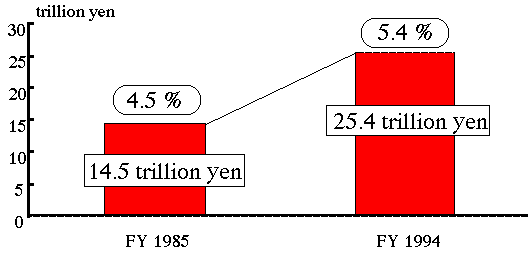
Notes:
- For the purpose of this document, the info-communications industry
refers to the telecommunications businesses (Types I and II telecommunications businesses), broadcasting businesses, communications and broadcasting equipment, communications lines, information equipment, audio-visual and games equipment, computer software, and content.
- The nominal GDP in fiscal 1985 was 324.2 trillion yen and 468.3 trillion
yen in fiscal 1994.
- Capital investment
The growth in the market scale of the info-communications industry
has been accompanied by increased capital investment. The 2.2
trillion yen investment figure of fiscal 1985 increased to 3.8 trillion
yen by fiscal 1994. The ratio of investment in the industry as a whole
also increased, from 8.7% to 9.2%.
Capital investment by Type I telecommunications businesses grew
to 3.5 trillion yen for fiscal 1995 (planned), thereby amounting to a
figure of 8.2% of all capital investment in Japanese industry as a
whole. The growth in the mobile communications sector, in
particular, is seen to be significant, moving swiftly within the space of
a few years, from 0.2 trillion yen in fiscal 1990 to 1.1 trillion yen in
fiscal 1995 (planned).
Ratio of capital investment by the info-communications industry
versus capital investment by Japanese industry as a whole
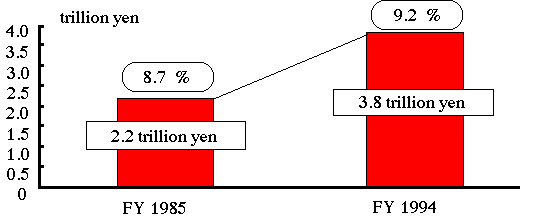
Notes:
- Investment figures for Japanese industry as a whole are taken from
"Survey Report on Corporations" (Economic Planning Agency).
- The investment figure for Japanese industry as a whole for fiscal 1985
was 25.3 trillion yen, while the figure for fiscal 1994 was 40.8 trillion yen.
Capital Investment by Type I Telecommunications Business
(planned for fiscal 1995)
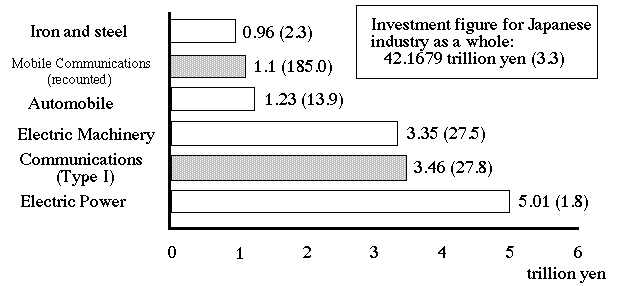
Notes:
- ( ): Comparison with previous financial year (%)
- Source: "Survey Report on Corporations"
(Economic Planning Agency), October 1995
- Employment
The growth in the info-communications industry has also exerted a
striking influence on employment. The number of people employed in
the industry (See note below) has increased from 720,000 in fiscal
1985 to 1,030,000 in fiscal 1994. The number as a percentage of the
entire Japanese workforce has also increased, from 1.2% to 1.6%.
In addition to increased employment opportunities in the software
sector, new competitors and the appearance of retail distributors in the
mobile communications sector are also important factors.
Number of employees in the info-communications industry
compared with the total number of employees nationwide
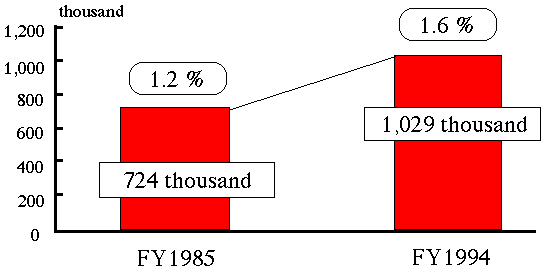
Notes:
- The total number of employees in Japan as a whole is taken from
"Annual Labor Survey" (Statistics Bureau, Management and
Coordination Agency).
- The total number of employees in Japan in fiscal 1985 was
58,070,000 and the number in fiscal 1994 was 64,530,000.
- The number of employees in the info-communications industry
includes both those directly involved in the info-communications
industry and those listed below:
- Workers employed in the retail distribution of mobile telephones, etc.
- Workers employed in the installation of PBX equipment, etc.
- Workers temporarily transferred from NTT to subsidiaries.
(5) Remarkable growth in mobile communications
At the end of fiscal 1984 (March 1985), the number of mobile
telephone subscribers was 40,000. Numbers then grew remarkably
within the space of a few years, reaching 2,130,000 by the end of fiscal
1993 (March 1994) and 4,330,000 by the end of fiscal 1994 (March
1995). A figure in excess of 10,000,000 (including the number of
Personal Handy-Phone (PHS) subscribers) is forecast for the end of
fiscal 1995(March 1996).
The major factors behind this rapid growth include technological
innovation, the promotion of competition policies through (a) a system
of seven operators of services including automobile telephones, portable
telephones and personal handy phones (PHS) in each regional block; (b)
provision of conditions for fair and effective competition by separation
and division of NTT's mobile communications businesses; and (c)
introduction of a COAM (customer owned and maintained) system of
terminal equipment.
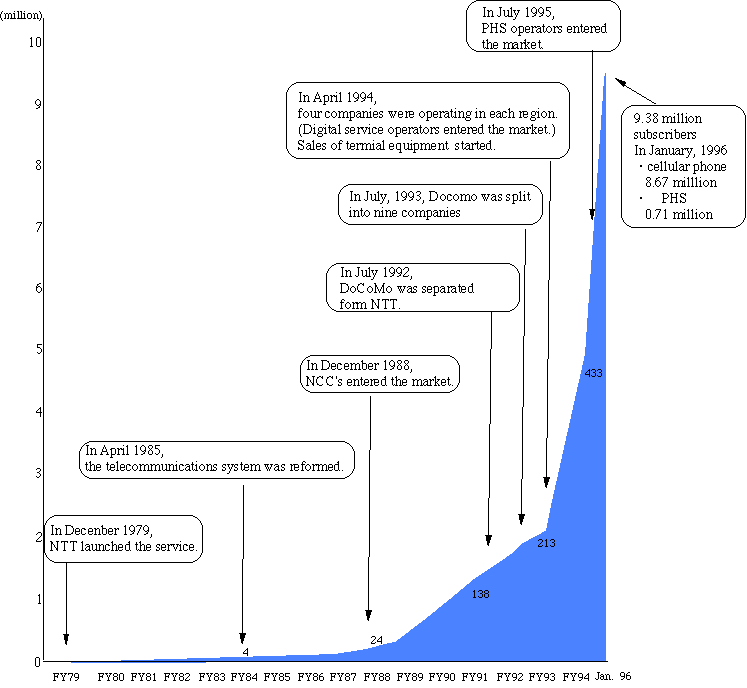

2. Future Issues
The first reform of the info-communications system in 1985 achieved
major results. However, the following problems have also been pointed
out:
(1) Rate reductions in monopolistic fields (from the present tendency of
increasing rates to rate reductions)
In Japan, some charges have been increased, including basic
subscriber rates, the price of local calls from public telephones, and the
charges for using leased circuit lines for short-distance calls (NTT has a
de facto monopoly.).
For example, NTT's basic subscriber charges (for households, class 3
exchange) have risen 13% from 1,550 yen in 1985 to 1,750 yen in 1995,
and the charges for local calls from public telephones (three-minutes
during daytime) increased from 10 yen in 1985 to 30 yen in 1994.
These communications charges are authorized according to the
procedures provided in the Telecommunication Business Law, and were
therefore properly applied.
Nonetheless, it is of great importance to achieve a further reduction of
communications charges overall, by taking drastic measures to enable
cost reductions to be made in monopolistic fields.
NTT's Rates
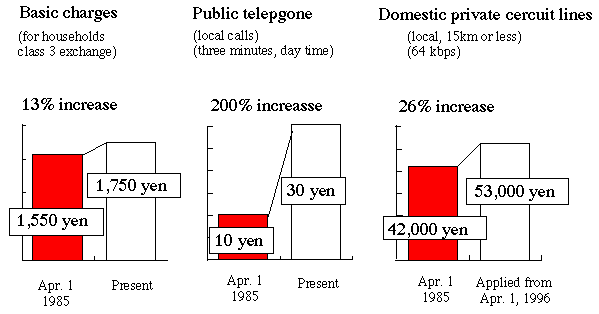
(2) Elimination of the gap in charges between Japan and foreign countries
In comparison with international prices, communication charges in Japan, with some exceptions, seem rather high.
For example, the installation charge for telephone subscribers of
72,800 yen in Japan is 4-13 times higher than that of the U.S., U.K.,
Germany or France. The domestic long-distance telephone charge
(maximum distance, Monday to Friday, three-minutes during daytime)
of 180 yen in Japan is also 1.3-4 times higher than that of the U.S., U.K.,
Germany or France.
Similarly, the short-distance leased circuit line charge (1.5 Mbps
equivalent, 15 km) is 3-6 times higher than that in New York or London.
Further reduction in communications charges overall is therefore
required to eliminate the rate gap between Japan and foreign countries.
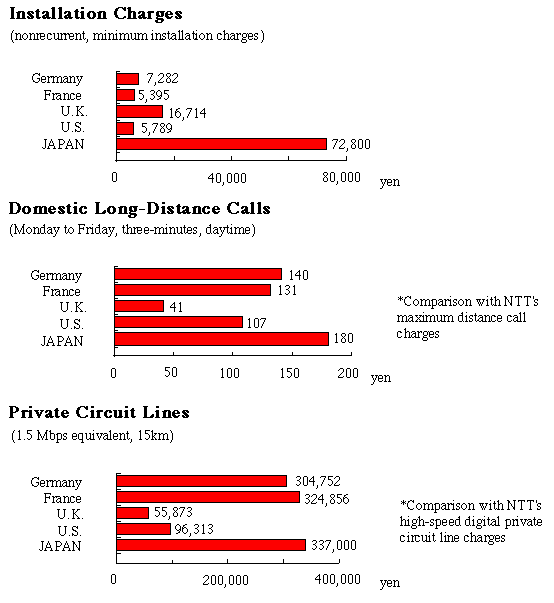
Notes:
- U.S. charges: NYNEX New York Telephone Corp. and AT&T.
- Exchange rates: As of January 4, 1996
(1 U.S. dollar = 105.26 yen, 1 pound sterling = 163.37 yen,
1 Fr. franc = 21.33 yen, 1 DM = 72.82 yen).
These rates apply hereafter.
(3) Diversification of services
The U.S. is regarded as offering a much wider range of services than
Japan. For example, 17 different types of discount services for long-
distance calls are offered by AT&T in the U.S., while NTT offers only
five types. Also, there are five different types of package discounts for
high-function services offered by the NYNEX New York Telephone
Corp., compared with NTT's one. The future introduction of diverse
services to meet users' needs is therefore also an important issue.
Additionally, to improve convenience for users, NTT must upgrade its
response to customers' requests, such as for installation or transfer of
services in weekends or holidays.
(4) Promotion of competition in the regional communications market
NTT maintains a monopoly situation in Japan's regional
communications, accounting for 99% of intra-prefectural calls.
As a result, the three long-distance NCCs paid 310.3 billion yen (or
49.4%) of their entire telephone income of 628.4 billion yen (for fiscal
1994; including interconnecting call charges) to NTT in the form of costs
for connecting to NTT's regional networks. Within such a monopoly, if
there is not enough incentive to make NTT's regional networks more
effective, the risk arises that it may hinder the lowering of charges by the
domestic and international carriers that employ NTT's networks for
subscriber accessing.
Promotion of competition in this monopolistic regional communications market is thus an issue of importance.
Status regarding payment of access charges to NTT
(Telephone; fiscal 1994)
| Total telephone income
(Note 1) | Total costs paid to NTT
(Note 2) |
Three Long-distance NCCs
(DDI Corp. Japan Telecom Co., Ltd. Teleway Japan Corp.) |
628.4 billion yen |
310.3 billion yen
(49.4% of the telephone income of the three long-distance NCCs are paid to NTT.)
|
Notes:
- Includes interconnecting call charges.
- Total of interconnecting call charges, rental fee for interconnection gateway
switches (IGS), modification costs of local switches (LS) and toll switches
(TS), and modification costs of local switches to send identification signals.
(5) Promotion of fair and effective competition
Against this background of the monopolistic regional networks, the
following obstacles have emerged to fair and effective competition:
- Issues pertaining to connection
It is becoming apparent that negotiations for NCCs' connection to NTT's regional networks are not proceeding smoothly. Japan is therefore lagging behind in terms of its introduction of new services.
For example, in 1989, the three long-distance NCCs applied to NTT for connections to enable them to provide VPN (virtual private networks) services. In February 1994, NTT started its own VPN service. In November 1994, because negotiations between NCCs and NTT were proving extremely difficult, the three long-distance NCCs applied to the Minister of Posts and Telecommunications for a connection order. In December 1994, the Minister ordered NTT to conclude a connection agreement with the NCCs, and, in May 1995, they started their services.
A similar situation also occurred with the setting up of a frame relay service.
- Issues concerning the abuse of private information
From 1993 to 1994, NTT made use of the telephone numbers of
unlisted subscribers (information only available to NTT through its
Regional Communications Operations Division) for purposes other
than the original ones to compete in the long-distance communications
service field. This was detrimental to fair and effective competition.
- Issues concerning terms of business
Various problems surrounding NTT's business methods are
emerging as hindrances to fair and effective competition. For
example, it has been pointed out that internal transactions pertaining to
facility charges (steel tower, gas maintenance facility, etc.) at NTT are
not conducted under the same terms as transactions with long-distance
NCCs.
Further promotion of fair and effective competition is therefore an
issue of some importance.
(6) Promotion of cross entry
The info-communications field currently provides services in each of
the following areas: domestic / international communications, regional /
long-distance communications, fixed / mobile communications,
communications / broadcasting, communications infrastructure / content,
and other business fields.
To more speedily promote a competitive environment, promotion of
cross entry into these service fields is a significant issue for the future.
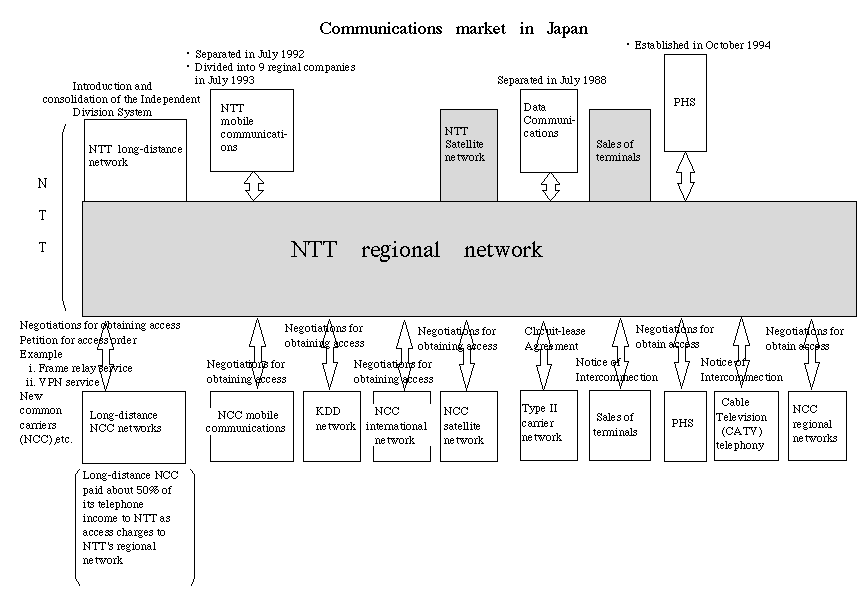
(7) Improvement of international competitiveness
- Development of business in overseas markets
The demand for the establishment of info-communications
infrastructure in Asia, Eastern Europe, Central and South America,
and other areas is increasing. Moreover, in the European and
American markets, the movement toward cross entry is also growing
as more and more policy steps are taken to promote competition. In
this situation, NTT and KDD of Japan have only entered seven
markets - in Asia, Russia, and the United States. Just considering
overseas investment figures alone, NTT (0.1 billion dollars) lags way
behind compared to the leading European and American
communications carriers (British Telecom (BT): 10.4 billion dollars,
AT&T: 9.2 billion dollars). Japan's development of business in
overseas market has therefore been rather slow.
- Note:
- The figures in parentheses are cumulative overseas investment
between 1987 and 1993 (Source: Communications Industry Association
of Japan).
- Alliances with overseas carriers
As described before in Chapter 1 4. (3) "Globalization", the
globalization of corporate activities is being accompanied by alliances
among communications carriers that transcend national boundaries.
The main examples are the moves to form three groups - World
Partners (comprised of AT&T and other carriers), Concert (mainly
made up of BT and MCI), and Global One (comprised of Deutsche
Telekom, France Telecom and Sprint).
Such movements provide competition in the international
telecommunications market. It is important to note that the
international communications market is a little under 5% (fiscal 1994)
of Japan's combined domestic and international communications
markets. In view of its capacity for future growth, carriers are
expected to respond positively. Among Japanese communications
carriers, KDD is involved with World Partners, as is NTT, but
experimentally, and with a time limit. However, Japanese
communications carriers have not yet reached a point where they are
playing a critical role in such international alliances.
- Provision of global communications services
As described in Chapter 1, 4. (3), "Globalization", by developing
mobile communications technology, such as the low earth orbit
satellite (LEO) communications technology, global communications
services will be further developed.
A positive approach is therefore required toward the future
development of global info-communications.
(8) Elimination of the informatization gap
Regardless of whether it involves networking (as can be seen with
personal computer communications and the Internet) or the
dissemination of personal computers and other forms of info-
communication equipment, or such contents as data bases and CD-ROM,
informatization in Japan is marked by enormous gaps when compared
with that in the United States, widely regarded as the world's most
advanced country in this area.
The elimination of these gaps in informatization therefore constitutes a
future issue of importance.
Examples of gaps in informatization between Japan and the U.S.
| U.S | Japan | Ratio by which usage per person in U.S. exceeds that in Japan (See Note) | Remarks |
|---|
E-mail boxes
(Unit: million) |
40.0 | 3.13 | 6 |
Foundation for Promotion of Telecommunications Services (1994) |
| Host computers connected to the Internet (Unit: 1,000) |
6,053 | 269 | 11 | Network Wizards Corp. (January 1996) |
| Personal computer shipments (Unit: million) |
18.40 | 3.35 | 3 |
- Japan:
- Japan Electronic Industries Development Association
- U.S.:
- IDC Corp.
(1994 figures for both Japan and the U.S.)
|
| Database operating revenues (Unit: billion yen) |
1,431.5 | 210.8 | 3 |
- Japan:
- Info-communications 1995 Year Book
- U.S.:
- U.S. Industrial Outlook 1994
(1993 figures for both Japan and the U.S.)
|
| Market scale of CD-ROM (Unit: billion yen) |
630.0 | 83.0 | 4 |
- Japan:
- White Paper on Multimedia
- U.S.:
- InfoTech Corp.
(1993 figures for both Japan and the U.S.)
|
| Cable TV subscribers (Unit: million) |
61.02 | 2.21 | 13
|
- Japan:
- Ministry of Posts and Telecommunications (1995)
- U.S.:
- National Cable Television
Association (NCTA) (1995)
|
| Mobile phone subscribers (Unit: million) |
28.15 | 5.35 | 3 |
- Japan:
- Ministry of Posts and Telecommunications
- U.S.:
- CTIA(June 1995 figures for both Japan
and the U.S.)
|
- Note:
- The figures of U.S./Japan per person are calculated by
(figures in the U.S./figures in Japan)¡ß(population in Japan/population in U.S.).
(9) Improvement of research and development capability
For the past few years there has been a balance between imports and
exports in Japan's trade in technology across industry as a whole.
However, a large import surplus has arisen in the fields of
communications, electronics and electrical measuring instruments. Also,
according to a survey conducted by the Science and Technology Agency,
in the three years from 1991 to 1994, research and development
capability in the fields of communications, electronics, and electric
measuring instruments in Japan is evaluated to have dropped from being
superior to being inferior to that in the United States. Furthermore,
according to the evaluation made by the Council on Competitiveness, a
private organization made up of key U.S. companies and universities, the
United States is in a superior position to Japan in many fields of private
sector info-communications, including the software sector.
Given this, we should aim to enhance R&D in Japan to a higher level,
considering the need to reform and improve existing conditions, rather
than taking a defensive stance simply to prevent the deterioration of the
current situation or to maintain the status quo.
Japan-U.S. Comparison of Corporate R&D Strength
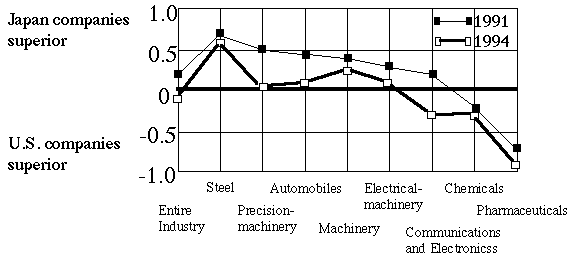
- Source:
- "Report on R&D Activities in Private Sector,"
Science and Technology Agency (fiscal 1994)
- Note:
- Company responses were scored as follows:
Japanese companies superior = +1, equal strength = 0, and U.S.
companies superior = -1. The scores were totaled and divided by the
number of responding companies to produce these indices of relative
superiority.
(10) Development of content
While Japanese content in the areas of games, animation, and karaoke
is internationally renowned, satisfactory development has not been
realized in such areas as the CD-ROM content industry.
It is therefore important to develop from now on content in various
areas, such as education, art, and the needs of daily life.
(11) Summary
The individual issues now facing the info-communications market are
described above. Taking all of them into account, it can be envisaged
that it will be necessary to examine reforms in the info-communications
market with the following aims.
- The realization of lower charges for the benefit of users and the
nation as a whole, as well as diverse services that meet their needs;
- The promotion of competition, particularly among
telecommunications carriers;
- The improvement of the international competitiveness of the
Japanese info-communications industry, such as by positively
responding to increasing globalization and by improving Japan's
research and development capability.
3. Assessment of the Results of "Measures to be taken in accordance
with Article 2 of the Supplementary Provision of the Nippon
Telegraph and Telephone Corporation Law"
(1) Promotion of "measures to be taken in accordance with Article 2 of
Supplementary Provision of the Nippon Telegraph and Telephone
Corporation Law" (i.e. government measures)
- The March 1990 report of the Telecommunications Council
proposed the following structural measures:
- Separation of NTT's long-distance communications business
from its local communications sector;
- Though requiring further study of the status of its regional
communications company, allowing NTT to operate as a single
entity for the time being.
However, implementation of these structural measures was
postponed for further consideration in fiscal 1995. Meanwhile, it
was decided instead to promote eighteen alternative non-structural
government measures, concerning "Promotion of Fair and Effective
Competition" and "Improvement of NTT Management."
- Since 1990, the Ministry of Posts and Telecommunications and
NTT have been striving to promote and realize those eighteen
measures. However, because the structural measures originally
proposed by the Telecommunications Council have not been
implemented, the results of the non-structural measures have only
been partially successful, as described below:
(2) Promotion of fair and effective competition
- Thorough establishment of the Independent Division System at NTT
Positive results have been achieved by the separation of the long-
distance communications business division and the regional business
division at NTT introduced in April 1992, and, from the same
financial year, the disclosure of separated revenue and expenditure
figures for these divisions.
However, although the objective of the introduction and thorough
implementation of the Independent Division System was to create
conditions for fair and effective competition, problems have arisen
regarding these aims as described below. Negotiations over
interconnection between carriers have not been conducted smoothly
and remain to be resolved. Cases of the abuse of information have
also emerged.
In addition, NTT has been criticized for promoting its business by
selling regional and long-distance services together, thus failing to
adequately promote fair and effective competition.
- Facilitation of network connections
Positive results have also been achieved by the measures (see note)
listed below, implemented to facilitate the connection of regional
communications networks to NTT.
- Easier establishment of points of interface (POIs)
- Making ID sending automatic
- Introduction of an end-to-end fee system for charges related to long-distance NCCs
- Introduction of an access charge system between carriers, etc.
However, within the structure of reciprocal interest that comes from
NTT managing its monopolistic regional division and its competitive
long-distance division together as one integrated business, difficulties
have occurred. For example, positive negotiations over
interconnection for frame relay services and VPN services have been
delayed for a long time, resulting in petitions being made to the
government to issue connection orders.
In addition, for the reasons described below, there is a lack of
incentive for NTT to reduce access charges and make technical
conditions more open:
- The time lag between an application for connection until actual
connection is still long.
- There is insufficient disclosure of the accounting method for
calculating the access charges and of documentation on which the
accounting is based.
- The three long-distance NCCs have to pay approximately 50
percent of their telephone revenue to NTT as access charges.
- There is no detailed breakdown of access charges for each type of
network equipment or function.
- It is unclear what the conditions are for connection to a local
switch.
- Connection to signal networks has not yet been realized.
- Note:
- "Facilitating Interconnection with New Common Carriers (NCCs)"
(NTT, March 29, 1991)
- Securing of openness of network
- Connection of Type II Telecommunications Carriers to NTT
In July 1991, the Open Networks Council was established for the
purpose of reflecting the demands of Type II telecommunications
carriers concerning the building of NTT networks, and to ensure
NTT provide its network functions smoothly to Type II
telecommunications carriers. To this end, the Council has
conducted several discussions. However, because Type II
telecommunications carriers are treated as users by NTT,
discussions between NTT and Type II telecommunications carriers
regarding the aspect of usage of network functions have not been
progressing smoothly.
- Interconnection to local switches of NTT
a) In March 1995, NTT announced its policies to make
interconnection possible at all stages (See note 1). In September
of the same year, NTT again announced its policies to make
interconnection to local switches, etc., possible (See note 2). In
February 1995, the Ministry of Posts and Telecommunications
called for NTT to carry out interconnection at all exchanges to
promote competition (See note 3). In that sense, progress has
been made by the announcement of such policies by NTT.
On the other hand, as described below, the details of NTT's
policies have not always been clear, and in some ways it is
difficult to evaluate them.
- If no standard interface is prepared, technical examinations,
design, and development need to be carried out every time an
application is made by an NCC, and, as a result, the waiting
time for interconnection might be prolonged.
- It is impossible to analyze whether NTT's cost for utilization
and the cost to be borne by NCC are at the same level when
the cost range and the calculation methods are unclear.
- In general, NCCs are required to shoulder the burden of the
cost necessary for interconnection. However, an NCC may
not be able to interconnect if it cannot shoulder such costs,
depending on the amount.
- Note 1:
- "Report on Concrete Measures for the Clarification of
Procedures in Negotiations for Connections" (NTT, March 31,
1995)
- Note 2:
- "Making Networks Open" (NTT, September 28, 1995)
- Note 3:
- "Clarification of Procedures in Negotiations for Connections
to the NTT Regional Communications Network" (Ministry of Posts
and Telecommunications, February 23, 1995)
b) Even if connection with local switches, etc., is achieved, the
present monopolistic situation with local switches and
subscribers' lines will continue, and there may not be enough
incentive for NTT to reduce costs.
c) Under these circumstances, it is difficult to evaluate how
successful NCCs have been in the area of connection to NTT's
local switches, and it is envisaged that, even if connection is
achieved, the monopolistic situation in the regional
communications network consisting of local switches and
subscribers' lines, will continue. How to reduce the costs of
these components, such as those of subscribers' lines (whose
costs comprise 25% of NTT's operation costs) therefore remains
an important issue.
- Prevention of cross-subsidization
In February 1992, the Ministry of Posts and Telecommunications
decided standards for the separation of accounting of revenues and
expenditures among business divisions (See note). These standards
are intended to clarify internal transactions between the business
divisions and to make internal transactions between the long-distance
communications division and the regional communications division of
NTT subject to the same conditions as transactions between long-
distance NCCs and NTT.
However, hindrances remain to fair and effective competition, such
as the fact that internal transactions at NTT are not conducted under
the same terms as transactions with long-distance NCCs, as described
above.
- Note:
- "Introduction and thorough implementation of the Independent
Division System of long-distance communications division and regional
communications divisions, classification of assets and debts regarding
disclosure of revenues and expenditures, standards for separate
accounting of revenues and expenditures, and etc." (Ministry of Posts
and Telecommunications, February 21, 1992)
- Prevention of information abuse
NTT has devised certain measures, such as putting internal
regulations in place, in connection with the appropriate use of
information. NTT has also instituted internal systems to prevent
information abuse. However, a series of incidents has occurred in
which confidential information on customers, obtainable only by
NTT through its local communications division, has been used for
purposes other than originally intended. It has also been pointed out
that subscriber information is not adequately protected.
- Positive disclosure of information
The following measures have been devised to deal with NTT
information that is indispensable to fair and effective competition, by
the revision of the telecommunications business report rules (See note
1) and by such administrative guidance (See note 2) as the
clarification of connection procedures.
- The disclosure of network information such as the number of
communications and volume of calls between message areas
(MAs).
- The establishment of contact offices to answer inquiries related to
the disclosure of network and technical information, etc., and the
creation of summaries of disclosable information (See note 3).
- Public announcements in Official Gazettes of additions or
changes to network functions that may influence terms for
connection.
However, as described above, there is still inadequate disclosure
of the information required for the connection to NTT local
communications networks. For example, the inadequate disclosure
of the calculation method for access charges and the accounting
documents that set out the basis for the calculation method.
- Note 1:
- Ministerial Ordinance of the Minister of Posts and
Telecommunications, No. 28, 1990 (Promulgated and enforced on May
30, 1990)
- Note 2:
- "The positive disclosure of information and diffusion of R&D
results" (Ministry of Posts and Telecommunications, March 15, 1991)
- Note 3:
- "Measures on positive disclosure of technological information and
diffusion of R&D results" (NTT, March 29, 1991)
- Diffusion of R&D results
According to NTT's disclosure standards, including their external
sale standards, the results of NTT's research and development can, in
principle, be disclosed at any time (See note), but NTT decides the
timing of the disclosure of the results of exceptional technology on a
case-by-case basis. Because the scope of such exceptional technology
is not clearly defined, transparency has been insufficiently secured in
disclosure of research and development results.
- Note:
- "Measures on positive disclosure of technological information and
diffusion of R&D results" (NTT, March 29, 1991)
'Report: Ideas for opinions by interested persons as regards "Concrete
measures to clarify procedures and other related matters concerning
interconnections negotiations"' (NTT, August 31, 1995)
- Mobile communications services
In July 1992, the mobile communications business was separated
from NTT and a new company NTT Mobile Communications
Network Corp., was launched. In July 1993, the new company was
then divided into nine regional companies.
Through the separation of mobile communications business from
NTT, problems regarding fair and effective competition, such as
cross-subsidization and the abusive use of information, have been
mitigated. Moreover, the regional division established a competitive
environment, enabling locally-operating mobile telecommunications
NCCs to compete on an equal footing with NTT mobile carriers.
The introduction of these conditions for fair and effective competition has led to the rapid growth of the mobile communications market through the abolition of telephone deposit fees (100,000 yen), and major reductions in rates such as a lowering of the subscription fees by approximately 87 percent, a reduction in the basic rates of approximately 43 percent, and a cut in call charges of approximately
12 percent.
In contrast, NTT finances NTT Mobile Communications Network
Corp., to an extremely high level of 95 percent. Consequently, it will
be important in the future to make NTT lower this level of capital
contribution, in order to establish the conditions for fair and effective
competition.
- Sales of terminal equipment
- In July 1990, NTT carried out revisions to its organization in
which the terminal equipment sales division and the
telecommunications business division were separated.
However, it has been pointed out that organizational and operational separation has not been fully completed. For example, there have been instances in which the terminal equipment sales division organization has not been separated from regional communications business headquarter branches. There have also
been instances in which sales of terminal equipment still continue
unchanged at regional communications business headquarter
branches from which the terminal equipment sales division has
been separated.
- Furthermore, it has been pointed out that there have been
instances in which NTT has used its position as a Type I
telecommunications carrier with a local circuit network and access
to subscriber information that only NTT could know to sell terminal
equipment.
- Satellite communications business
The separate accounting of revenue and expenditure in the satellite
communications business since fiscal 1990 can be favorably
evaluated.
It is necessary to establish conditions for fair and effective
competition by aiming to secure equality between NTT and satellite
NCCs in NTT regional communications networks in the future.
NTT now has its own satellite, N-STAR. However, at present NTT is to use N-STAR to complement the terrestrial network, and the satellites of other carriers are to be used for services NTT provides to users.
- Earlier completion of digitization
Plans to complete digitalization by the end of fiscal 1997 are proceeding smoothly and can be favorably evaluated.
- Future numbering plan
The development of fair and effective competition has been hampered by problems such as the lack of equality between NTT and NCCs, and the fact that number portability has not been established. (i.e., a subscriber can use the same number even after changing carriers.).
- Policies on establishing message areas (MA)
At the Ministry of Posts and Telecommunications, the study
committee on policies concerning short-distance telephone calls
compiled a report (June 1992) and indicated measures for
improvement of policies on establishing MAs. However, it has been
pointed out that progress is not being made in examinations within
NTT concerning policies on MAs and that no fundamental review is
being undertaken on such policies in response to the increasing need
by the people in economic and day to day activities.
- Introduction of discount rates applicable to telecommunications
carriers
Rates below those charged to users are established, reflecting
differences in forms of equipment usage, by means such as excluding
charges related to product sales activities. These rates are access
charges between carriers for long-distance NCCs, work consignment
fees to KDD and international NCCs, access charges for use of leased
circuit lines as access lines, and non-tariff service charges for special
type II telecommunications carriers providing packet communications
services.
However, there has not been any improvement in the situation
whereby NTT does not have any incentive to introduce discount rates
for telecommunications carriers, given that NTT has a de facto
monopoly on the regional communications network.
(3) Improving NTT management
A. Promotion of rationalization
- There will be a strong demand from now on for a reduction in rates
for information and communications services across the board to
promote the development of multimedia, the creation of a lower cost
structure across the spectrum of Japanese industry, and an
improvement in international competitiveness.
- NTT is a key telecommunications carrier with the lion's share of the
domestic communications market and its rates have a major influence
on the communications costs that the Japanese economy has to bear.
NTT's regional network costs are borne by all carriers that depend
on the NTT's regional network.
- Accordingly, the lowering of NTT's network costs, and in particular
the cost of its regional communications network, is needed. And from
this point of view, promoting improvements in NTT management,
namely rationalization, is an extremely important issue.
- The fact that NTT has endeavored to cut the number of personnel is
a positive factor (There were 310,000 employees at the time of
privatization in 1985. By the end of FY 1994, this has been reduced
to less than 200,000.). However, on the other hand:
- There are 30,000 employees who have been temporarily
transferred to subsidiaries, and the source of salaries for these staff
members is budgeted for in NTT's work consignment fees paid to
these subsidiaries.
- The ratio of the sum of personnel expenses and work consignment
fee to NTT's total expenses has increased annually since
privatization, reaching 47.9 percent in fiscal 1993 (up from 41.8
percent at the time of privatization).
Consequently, the reduction of employees by separating a business
into subsidiaries, which is the method recently used by NTT, needs to
be evaluated from the viewpoint of whether such reduction will lead to
management efficiency.
- In June 1995, based on the recommendations of administrative
inspections, the Management and Coordination Agency pointed out
that it was necessary to rationalize the number of personnel according
to work load, the further abolition and integration of branches and etc.
The recommendations pointed out the lack of thoroughness in
allocating staff based on work load in NTT's telephone number
information service, maintenance service, 116 service (orders, etc.)
and 113 service (complaints), as well as the lack of thoroughness in
abolishing and integrating work unit locations and etc.
- Furthermore, the administrative inspection recommended that it was
necessary for the Ministry of Posts and Telecommunications to
instruct NTT to achieve a greater management efficiency by devising
new, voluntary rationalization projects, and rationalizing and making
greater efficiency of both staff and operations in every area of
business.
In response, NTT submitted a report to the Ministry of Posts and
Telecommunications in September 1995 on what steps would be
taken. However, the report failed to clarify the concrete details and
the time frame for these steps to be implemented. Although the
Ministry has instructed NTT to clarify these points and to swiftly
respond in report form, NTT has not yet dose so.
- In addition, in November 1995, NTT announced that it would pare
down its employees to 150,000 by the year 2000. However, since
concrete measures and the time frame have not yet been clarified what
cost saving there will be is far from clear.
NTT's Personnel Expenses
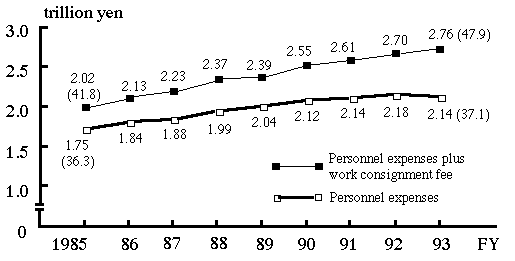
- Note 1:
- The figures in brackets are percentages of total expenses.
- Note 2:
- "Report on the results of administrative inspection over
telecommunications business" (Administrative Inspection Bureau,
Management and Coordination Agency, June 1995)
B. Maintenance division
Owing to the increased digitalization of facilities and the
introduction of remote supervisory and controlling equipment, the
number of staffed NTT maintenance branches for switches were
consolidated into 250 locations by the end of FY 1994 down from 470
locations at the end of FY 1989. Also, to promote greater efficiency
initiatives have been taken to shift external equipment surveying and
regular checking maintenance work to subsidiaries. However, it has
been pointed out that it is necessary to carry out further planned
rationalization of staff by consolidating the staffed maintenance
branches that carry out decentralized maintenance work on NTT
switches and wireless transmission equipment into one per prefecture.
C. Return of Profits to stockholders
In September 1995, based on profits made by NTT from selling its
shares in NTT Data Communications Systems Corp., accompanying
the listing of NTT Data Communications Systems Corp. on the stock
market in April of the same year, a dividend in the form of a 0.02 NTT
share was made available for each NTT share held.
(4) Future status of regulations
A. The major deregulatory steps taken so far are described below:
- In May 1992, the NTT and KDD Laws were revised, to permit up to
20% of NTT and KDD to be owned by foreign companies, in addition
to equity financing for NTT.
- The Emergency Measures for the Economy in September 1993
facilitated the introduction of the "COAM (customer owned and
maintained)" system of mobile/cellular phones from April 1994 and of
radio-paging from March 1995.
- In October 1995, the Telecommunications Business Law was
amended, to enable the prior-notification system to be applied to rates
other than those closely linked to the people's lives and the economy.
As a result the number of subjects requiring authorization was reduced
by more than half.
- In January 1996, it was announced that the Ministry of Posts and
Telecommunications would introduce a deregulating policy, named
the Promotion of Deregulation for the "Second Info-Communications
Reform," aiming at greater flexibility in entrustment of business
activities and for further deregulation of rates.
B. Concerning regulatory status, there are, for example, the following
arguments:
- The existing interconnection framework requires that
interconnection issues be left to consultation between carriers. This,
however, has partly been the cause of the lengthy negotiations over
interconnection with NTT, which enjoys a monopoly of local
telecommunication networks.
Therefore, the administrative authorities should swiftly consider the
establishment of basic rules, namely, taking legal measures (e.g.,
making interconnection obligatory, and introducing a tariff system for
interconnection).
- The categories of domestic communication for NTT and
international communication for KDD had proved useful in the
construction of facilities and the provision of efficient services under
the conventional specialized structure. However, the categories need
to be reviewed in the interest of stimulating the info-communications
by promoting cross market entry.
Furthermore, KDD - having no "bottleneck" facilities - should
promptly be allowed to undertake domestic telecommunications, even
if NTT's entry into the international telecommunications market is
delayed until structural measures are implemented.














